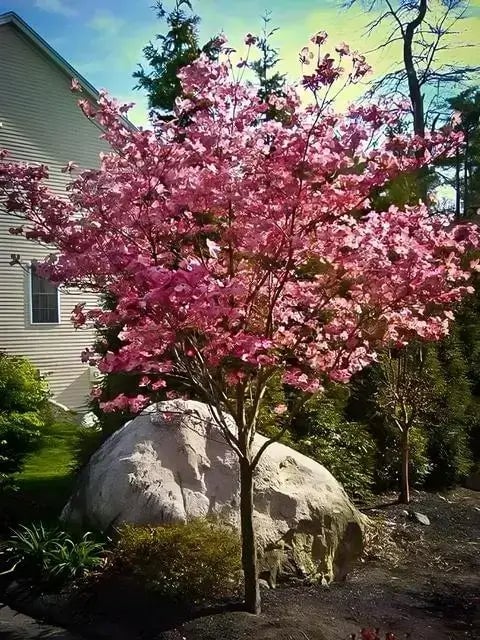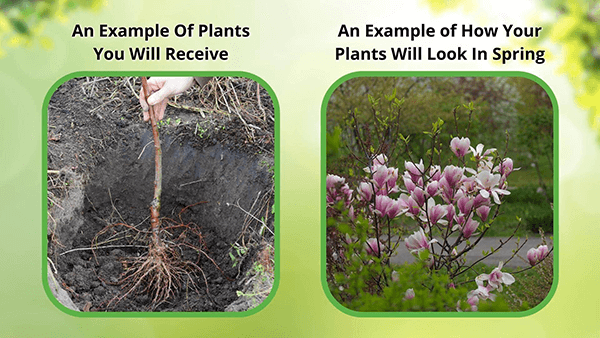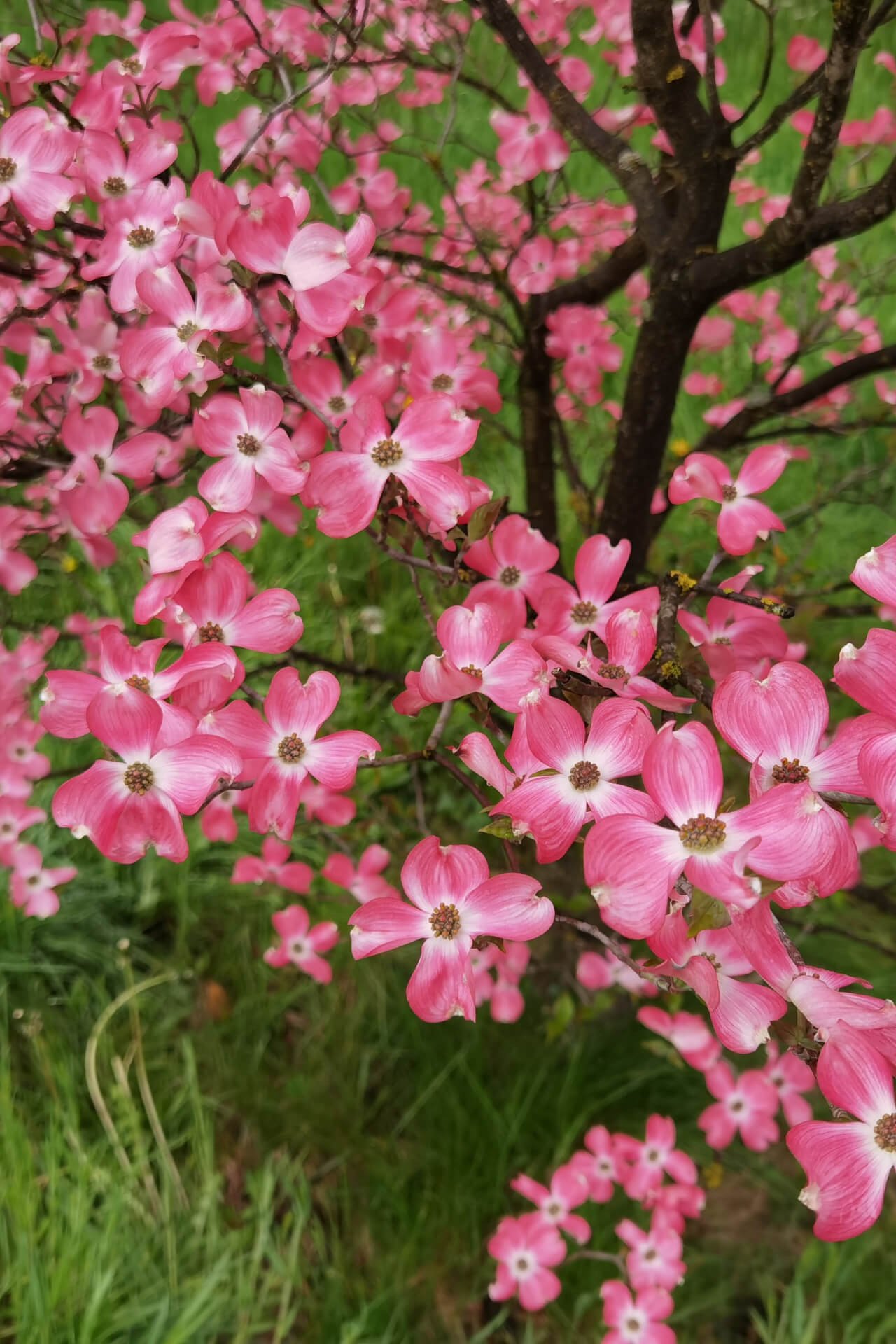



Pink Princess Dogwood
This plant ships:
NowWe sell bare root plants - click here to see what you'll receive
Pink Princess Dogwood - Cornus Florida Var. Rubra
Pink Princess Dogwood is a small, deciduous ornamental tree known for its delicate rosy-red blossoms, typically blooming in early spring. These blossoms add beauty and charm to landscapes. They are a prized addition to landscaping projects, offering an array of advantages encompassing aesthetic, ecological, and practical benefits. Their unique attributes create a harmonious interplay of visual beauty, environmental support, and functional value, making them a favored choice among landscape designers and homeowners.
The Pink Princess Dogwood Is Very Distinctive
The distinctive color of its flowers, which stands out against the backdrop of emerging green foliage, creates a captivating focal point in gardens and yards.
Ecologically, it contributes to the local ecosystem. Its blooms provide nectar for pollinators like bees and butterflies, fostering biodiversity and facilitating essential ecological interactions. The tree's berries, which follow the flowers, offer nourishment to birds and small mammals, further enhancing the interconnectedness of the local wildlife community.
Pink Princess Dogwood Can Be A Focal Point In Landscaping
Functionally, it offers practical benefits as well. Its moderate size makes it suitable for various landscaping applications, including as a specimen tree or as part of a mixed border. Its adaptability to multiple soil types and growing conditions enhances its usability in diverse landscapes. The tree's deciduous nature introduces the allure of changing seasons, with its vibrant autumn foliage offering an additional burst of color.
Furthermore, its distinctive variegated foliage and rosy, cream, and green splashes enhance its year-round visual appeal. This trait adds an extra layer of interest and beauty to the landscape even when the tree is not blooming.
In conclusion, they bring many benefits to landscaping designs. From its captivating aesthetic allure and ecological contributions to its practical versatility and year-round visual appeal, this tree enriches outdoor environments. Its capacity to infuse landscapes with elegant beauty, attract pollinators, and provide both visual and ecological value positions it as a cherished choice for those seeking to create visually pleasing and ecologically vibrant landscapes.
It Is A Captivating Small Built Tree
Cornus Florida is a captivating and ornamental tree native to the eastern United States. It is renowned for its exquisite beauty, particularly its striking rosy or rosy-hued blossoms that adorn its branches in the early spring. These blossoms make it a beloved and sought-after addition to gardens and landscapes.
This tree generally grows to 15-30 feet tall, with a slightly wider spread, forming a rounded or vase-shaped canopy. Its signature feature is its profusion of showy, four-petaled flowers that appear in clusters, known as bracts. These bracts are not the actual flowers but modified leaves surrounding the small, inconspicuous real flowers. The bracts start as soft, pale, and rosy and gradually deepen in color as they mature, creating a captivating gradient of hues.
As the seasons progress, the tree undergoes a mesmerizing transformation. The tree symbolizes roses and beauty in spring, attracting pollinators like bees and butterflies. During summer, its vibrant green foliage provides a lush and cooling canopy. In the fall, the leaves turn shades of crimson, scarlet, and burgundy, adding a rich tapestry of color to the landscape. Moreover, it produces small, shiny red berries that birds find valuable in autumn.
This tree is prized for its beauty and adaptability to various soil types and sun conditions. It is often used as an understory tree in woodland settings, where its delicate blossoms contrast beautifully with the dappled light filtering through the canopy.
It is A Symbol Of Grace
It is not just a tree but a symbol of grace, resilience, and the enduring beauty of nature. This magnificent plant is a true spectacle with its delicate and intricate petals, vibrant colors, and captivating fragrance. Its blossoms, in various shapes and sizes, change with the seasons, offering a constantly evolving display of beauty throughout the year. Whether found in gardens, parks, or natural landscapes, this exquisite plant never fails to impress, inspiring feelings of wonder and awe in all who have the privilege of experiencing its splendor.
Facts about the flowers?
The flowers are small and clustered, but petal-shaped leaves enhance the trees' vibrancy.
How long will it live?
If planted well, they will be 30-40 years old by the time they are ready to harvest. Appropriately watered, fertilized, and shielded from pests and diseases, they can easily live for 30 years or more.
What's the best spot to grow one?
They grow in well-drained, acidic, moist soils in partly shaded or indirect sunlight. Planting in a sunny place is recommended, and the plant should have enough room to branch horizontally to have a strong root system.
What makes mine not bloom?
Even a disease-free and healthy tree can fail to flower for one of several reasons, including light problems, untimely pruning, or an absence of nutrients. Late frosts or drought conditions can also trigger this. So, we need to take the proper precautions to get it to flower.
What is the ideal fertilizer for them?
Pink Princess Dogwood will respond to slow-release, diluted nitrogen-phosphorus-potassium fertilizers such as 12-4-8 or 16-4-8. This solution should be used between February and March or September and October because the plants will have had a break from it.
| Planting zone | [5, 6, 7, 8, 9] |
|---|---|
| Bloom season | Spring |
| Bloom color | Pink |
| Height At Maturity | Under 25 Feet |






Pink Princess Dogwood
This plant ships:
Now| Planting zone | [5, 6, 7, 8, 9] |
|---|---|
| Bloom season | Spring |
| Bloom color | Pink |
| Height At Maturity | Under 25 Feet |

